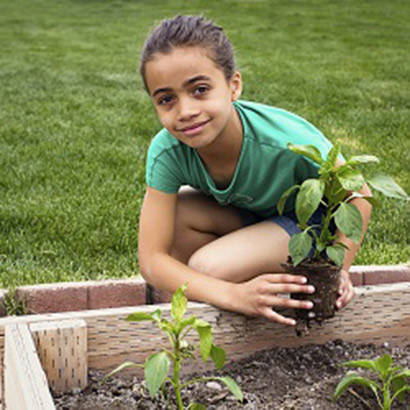
Patterson Park is a 155-acre park in southeast Baltimore. It is surrounded by diverse neighborhoods, some of which are gentrifying. The area is characterized by a broad income range from lower income to middle class with a multi-ethnic mix. The Friends of Patterson Park (FPP) was incorporated in 1998 as a nonprofit organization to promote and protect the park, serve as a liaison between the community and the Baltimore City Recreation and Parks Department, increase financial and human resources available for park projects and programs, and foster park stewardship in the community.
Community gardening in Patterson Park has a long history. City records show land designated for this use as far back as 1904. The Baltimore City Recreation and Parks Department Horticulture Division now offer garden plots in Patterson Park for rental as part of the City Farms program. FPP is developing a new garden program that will be called the People’s Garden. The People’s Garden is based on a plan by a local Master Gardeners group. Unlike the community gardens, which are in a fenced area and for which a $20 rental fee is charged, the People’s Garden is intended to be open and accessible to the community. Currently with four raised beds and 18 fruit and nut trees, FPP envisions a garden that community residents of all ages will tend and harvest on their own. In addition, the FPP plans to add six more beds.
The objectives of the youth gardening component of the People’s Garden are:
- To teach children gardening skills
- Give children an appreciation of where food comes from
- Teach children healthy eating habits
- Provide exercise opportunities
- Increase their sense of ownership of the park
Callie Schwartz, Friends of Patterson Park staff member, mentioned that while there are many convenience stores in the area, it is a long walk to the nearest grocery stores. For this reason, children tend to have greater access to junk food. Consequently, the garden program actively promotes nutrition. Kathy Harget, the Executive Director of the Friends of Patterson Park summed it all up by saying, “[through the garden project] they will learn to appreciate what this park has to offer, and then in return, what they can offer the park.”
The People’s Garden is being developed through a combined effort. NRPA funding has been used for building raised beds, paying staff, as well as buying tomato seeds and plants, soil, and other garden supplies. An AmeriCorps worker built the beds, and FPP staff helped to fill them with soil. The fruit and nut trees were provided by the U.S. Department of Agriculture, and the city supplies the water. Staff from Johns Hopkins Medical Center and Sheppard Pratt Health System, a private, non-profit behavioral health organization, provided nutrition classes for families. A lot of the actual garden work this past summer was done by groups of volunteers who live in the surrounding neighborhoods. For example, an informal group of Spanish-speaking families came to help out, as did another volunteer group, called the Detail Detail Team, which undertakes various projects in the park. In addition, an FPP staff member reached out to participants in FPP soccer and walking groups — resulting in an additional 29 children and 17 adults working in the garden.
Ms. Harget and Ms. Schwartz see many opportunities for the garden’s expansion. They would like to have more garden space and more children and families involved through the schools and the surrounding neighborhoods. They envision possibilities for strengthening the garden’s educational component, using it as an outdoor classroom for teaching urban farming and nutrition. Ms. Schwartz has worked with four public schools within walking distance of the park. She noted that, “They all have garden clubs [and] I would like to see if they would be interested in using this as another outdoor space — an outdoor classroom.”
The program’s biggest challenge has been staff turnover, and FPP is currently in the process of rebuilding the staff. Along with the challenges of staff turnover that FPP has faced, there have also been successes — harvesting from the new raised beds and involving children and families from the community over the summer. A ground breaking event in November 2010, when the fruit and nut trees were planted, attracted local officials and the press and provided great publicity for the garden program.
FPP is working toward financial sustainability of the People’s Garden. Because urban farming has become active and popular in Baltimore, Ms. Harget believes that local foundations will be interested in funding the garden. She is also working on attracting corporate sponsorships to help support the garden as well as FPP’s general operations.
